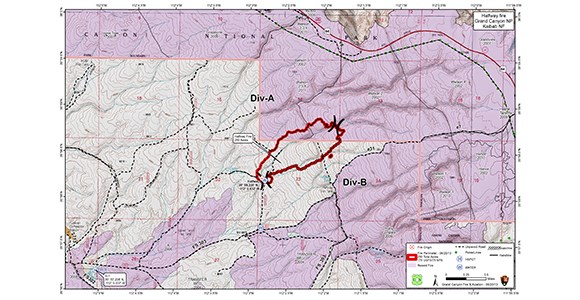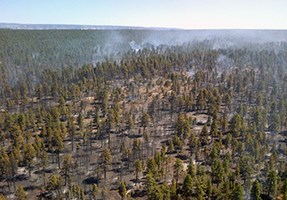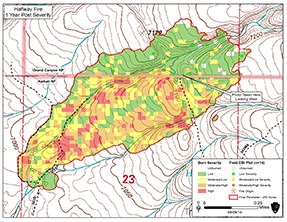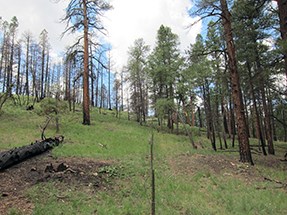Last updated: January 17, 2017
Article
Wildland Fire: Previous Fuels Treatments Change Fire Behavior

The June 2013 Halfway fire is an excellent example of how strategically planned prescribed fire treatments can be effective in limiting the spread of future wildfires, protecting values at risk, and reducing fire suppression costs.

The Halfway fire was initially reported on Wednesday, June 19, 2013, at approximately 2:55 pm on the Kaibab National Forest (KNF) in a predominantly ponderosa pine forest. By 6:00 pm, the fire had entered Grand Canyon National Park (GCNP). Existing weather conditions at the site were extreme, including single digit humidity, 20 mph winds, a red flag warning in effect, and a fire danger rating of “extreme” throughout the forest and park. Interagency fire personnel contained the fire at 250 acres on June 20, with 175 acres on the Kaibab National Forest and 75 acres in Grand Canyon National Park.
Despite extreme conditions, fire behavior decreased dramatically as the fire moved into areas that had experienced fire as often as three times in the past 20 years, with the most recent activity being a prescribed fire in 2011. Fire managers observed reduced flame lengths of two to three feet in these areas, as well as minimal smoke production, as fuels, or burnable vegetation on the forest, had been significantly reduced over the years as a result of the treatments. Additionally, the reduction in available fuels resulted in reduced negative smoke impacts to public safety and health both in the park along Highway 64, as well as in the community of Tusayan, Arizona.

View a larger version of map pictured right showing burn severity in various areas of the fire.
The quick, safe suppression of this fire was a direct result of interagency collaboration and a long-term history of hazardous fuel reduction through carefully planned and implemented prescribed fire treatments. The use of prescribed fire, particularly multiple entries, aids park managers in maintaining a historically accurate and ecologically necessary mosaic of heterogeneous fuels across the landscape. This healthy fire history helps reduce the likelihood of catastrophic wildfires and maintains the natural ecological process and landscape resilience.
Proper forest and fire management practices help to protect human life and property in addition to cultural and natural resources. In the absence of fire, hazardous fuel accumulations can pose significant risk to citizens and communities and pose great difficulties to firefighters in fire control efforts. Wildfires that burn in ponderosa pine forests that have not been treated with prescribed fire are also likely to result in negative impacts to forest health and ecological integrity.

Unplanned wildfires often produce extensive amounts of smoke, which affects air quality, both from a health and visibility perspective. Without the benefits provided from the prescribed fire treatments, the Halfway fire would have grown significantly in size and complexity due to extreme fire conditions. Overall, significant changes in fire behavior and associated impacts were observed, resulting in large cost savings, increased firefighter safety, reduced public impacts, and minimal ecological damage.
Contact: Daniel Pearson, fire management officer
E-mail: daniel_pearson@nps.gov
Phone: (928) 638-7934
